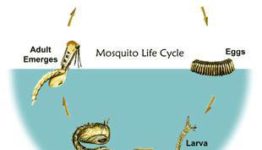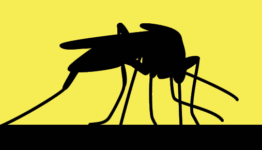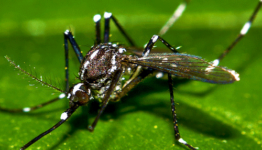Aedes
Aedes is one of the commonest genus of mosquito that lives mostly in tropical regions. They are virtually in every corner of the world except Antarctica. So far, more than 700 species of Aedes mosquito has been identified, with the commonest species being the Aedes albopictus, Aedes aeypti, and Aedes vexans. The Aedes mosquito just like every other genus of mosquito are most active at nights.
- Aedes albopictus: Otherwise known as Asian tiger mosquito, no other specie of mosquito ravages the world more than the Aedes albopictus. Asian tiger mosquitoes found their way into the United States during the 80s when used tires came in through the borders. Shortly afterwards, the mosquito spread so quickly that in a couple of years, it had covered over 26 states and 900 counties. This breed of mosquito is particularly deadly due to its aggressive nature, with an average female mosquito feeding several times a day
 on human blood. They carry with them deadly diseases like La Crosse, West Nile Virus, Dengue and Chikungunya. Due to their aggressive nature, the Asian tiger mosquito are always on the hunt for the blood of warm blooded animals, particularly that of humans. Their favorite spot is the ankles. When they want to rest, they would find short shrubs and areas with coverings. Their bites are quite painful and discomforting. Even the Yellow fever mosquitoes aren’t as aggressive as the Asian tiger mosquito.
on human blood. They carry with them deadly diseases like La Crosse, West Nile Virus, Dengue and Chikungunya. Due to their aggressive nature, the Asian tiger mosquito are always on the hunt for the blood of warm blooded animals, particularly that of humans. Their favorite spot is the ankles. When they want to rest, they would find short shrubs and areas with coverings. Their bites are quite painful and discomforting. Even the Yellow fever mosquitoes aren’t as aggressive as the Asian tiger mosquito. - Aedes aegypti: Otherwise known as the Yellow fever mosquito are vectors of diseases like Zika Virus, Yellow fever, Chikungunya and Dengue. Like the Asian tiger mosquito, the Yellow fever mosquito stay active through the day and way into the nights. Don’t be surprised when you wake by 4 am only to find one feasting on your blood – these things don’t sleep. Their favorite hideouts include wardrobes, empty containers and places devoid of light. They love resting in cool and shady areas. Not only are they aggressive, they are highly adaptable and till date, no effective control solution against this set of pest has been found. Even in the driest environmental condition, the eggs of this mosquito would survive. The female yellow fever mosquito is in the habit of laying her eggs in dry places in the hope of their eggs receiving moisture someday.
- Aedes Vexans: There is no state in America where you wouldn’t find this breed of mosquito. Pest control agencies have determined that their population stretches from California straight unto Alaska, to Florida and even to the east of Quebec. The Aedes Vexans is notorious in New Jersey, and no success has been recorded so far in the bid to contain their population. They are considered as a bridge vector for West Nile Virus in the sense that they transmit the deadly virus from birds to humans. You will mostly find them in shady areas where there is very little light. Their favorite breeding sites include drainage ditches, marshes, and storm sewers. They possess sturdy wings capable of carrying them on long flights.
Culex
The bites from Culex mosquitoes are really painful and irritating. They are most active during nights and are always on the hunt for human blood. Their wings are only strong enough to carry them through short distances.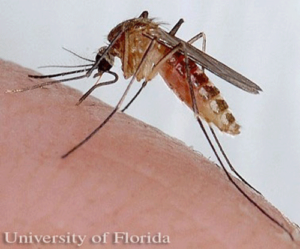
- Culex pipiens: Otherwise known as the northern house mosquito, they are the most widespread mosquito across the world. The only place you won’t find them is of course Antarctica. Their favorite breeding sites are containers holding standing water. To keep them off your home, you will have to clear every empty container. Culex pipien transmits West Nile virus whenever they feast on human blood. Western Equine encephalitis and Heart-worm which affects dogs are some other parasite this breed of mosquito carry with them. They prefer to hunt at night or during dusk when there is little light
- Culex tarsalis: No specie of mosquito in the entire North America transmits Western Equine encephalitis and St. Louis virus. This specie of mosquito breed in large population in places like North of Mexico, the southern part of Canada and even in California especially in places with elevation as high as 3000 meters. Their feeding time starts few hours after sunset. Blood of birds are their favorite, though they find the blood of mammals very attractive. They locate their host by tracking the carbon dioxide we exhale or certain acids contained in the sweat of mammals. When they want to rest, they would locate undisturbed shady areas like the cavities of trees and burrows of underground rodents.
- Culex restuans: This specie of mosquito transmits both St. Louis Encephalitis (SLE) as well as the deadly West Nile Virus (WNV). Their preferred breeding site include streams with a bubbling ecosystem, woodland pools, ditches, and every other place where you would find standing water. Some scientist are of the opinion that the Culex restuans feeds mostly on the blood of birds, hardly ever coming near humans. Whatever be the case, what we know for sure is that the Culex Restuan is a heck of an annoying pest
Anopheles
When you think about malaria, the very first thing that will pop to the mind is the Anopheles mosquito – no other specie of mosquito transmit Malaria as much as Anopheles does. Only about 30 to 40 out of the 430 identified species of Anopheles mosquito transmit malaria. Over the years, this malaria borne insect have so adapted that insecticides barely affects them. They also transmit heart worm – a deadly worm that kills our beloved canines. The Anopheles locates its host by tracking the carbon dioxide we exhale and the ammonia contained in our sweat.
- Anopheles freeborni: This breed of mosquito thrives well in dry and arid lands. You will mostly find them in the Western part of Canada and the US. They hunt for blood at night, though sometimes emerging during the day when locate an unsuspecting victim located in a shady area.
- Anopheles quadrimaculatus: No other insect transmits malaria as much as the Anopheles quadrimaculatus They breed mostly in the southern, eastern and central part of the United States. Unlike the Culex mosquito that lays her egg both on polluted and stagnant water, the Anopheles mostly lays her egg on standing water surrounded by vegetation. Their favorite breeding sites include lakes, swamps and ponds. When they are need of blood, the female would go after humans and large mammals.
Ochelerotatus
Whenever mosquito breeding season starts, the Ochlerotanus is always the first to appear. Their bites are really painful, and they are most active during the day. They barely come around private homes, and their preferred host are humans. They possess strong set of wings capable of flying them incredible miles away from their breeding site.
- Ochlerotatus triseriatus: Otherwise known as the Eastern Tree Hole Mosquito, over 36 known specie of the mosquito has been identified till date. La Crosse Encephalitis virus and West Nile virus are the two major virus this insect transmits. They are mostly found in the southern part of the United States where there are lots of Rocky Mountains. They are pretty aggressive and would attack both in the day and at night.
- Ochlerotanus Canadensis: Mostly breeding during late spring, this mosquito voraciously sucks the blood of humans and mammals without apology. Their favorite breeding site include swamp borders, hummock areas and woodland pools. They are believed to be the vector of EEEV
Culiseta
An aggressive breed of mosquito, the Culliseta attacks both in the day and at nights. Their preferred breeding ground include fishponds, especially those in private homes.
- Culiseta melanura: Acidic water with pH value as high as 5.0 are their favorite breeding site. They only feed on the blood of birds, staying completely away from humans. A native of New Jersey, the Culiseta Melanura is responsible for transmitting EEEV amongst birds. Some mosquito species like Coquillettidia perturbans transmits the virus among humans.
Coquillettida 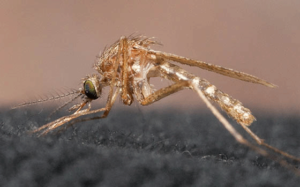
This freshwater breeding genus of mosquito can be easily identified with its yellow stripped body.
- Coquillettidia perturbans: Mostly found in the northern part of America, this breed of mosquito is a common vector of EEEV. They are most active during the nights, but won’t mind feasting on a host when the lights are out. They are long range flyers, and travel several miles away from their home. You would find them in the Great plains and Rocky mountains of eastern America, though in small numbers.



